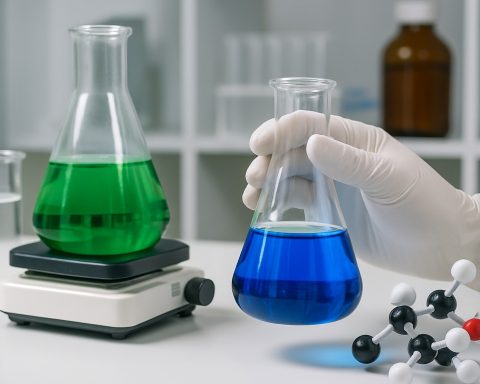Chiral Pharmaceutical Synthesis Market Report 2025: In-Depth Analysis of Technology Advancements, Competitive Dynamics, and Global Growth Projections. Explore Key Trends, Regional Insights, and Strategic Opportunities Shaping the Industry.
- Executive Summary & Market Overview
- Key Technology Trends in Chiral Pharmaceutical Synthesis
- Competitive Landscape and Leading Players
- Market Growth Forecasts and CAGR Analysis (2025–2030)
- Regional Market Analysis and Emerging Hotspots
- Future Outlook: Innovations and Strategic Roadmaps
- Challenges, Risks, and Opportunities for Stakeholders
- Sources & References
Executive Summary & Market Overview
Chiral pharmaceutical synthesis refers to the production of enantiomerically pure compounds—molecules that are mirror images of each other but not superimposable—crucial for the efficacy and safety of many drugs. The global market for chiral pharmaceutical synthesis is experiencing robust growth, driven by the increasing demand for single-enantiomer drugs, advancements in asymmetric synthesis technologies, and stringent regulatory requirements for enantiomeric purity in pharmaceuticals.
As of 2025, the chiral pharmaceutical synthesis market is valued at approximately USD 90 billion, with projections indicating a compound annual growth rate (CAGR) of 8-10% through 2030. This growth is underpinned by the expanding pipeline of chiral active pharmaceutical ingredients (APIs), particularly in therapeutic areas such as oncology, cardiovascular, and central nervous system disorders. The shift from racemic mixtures to single-enantiomer drugs, which offer improved pharmacological profiles and reduced side effects, is a key market driver Grand View Research.
Technological advancements in asymmetric synthesis, biocatalysis, and chiral chromatography have significantly enhanced the efficiency and scalability of chiral drug production. Major pharmaceutical companies are increasingly investing in these technologies to streamline manufacturing processes and meet regulatory standards set by agencies such as the U.S. Food and Drug Administration and the European Medicines Agency. Additionally, the rise of contract research and manufacturing organizations (CROs and CMOs) specializing in chiral synthesis is contributing to market expansion by offering cost-effective and flexible solutions for drug developers Fortune Business Insights.
Regionally, North America and Europe dominate the chiral pharmaceutical synthesis market, owing to their advanced healthcare infrastructure, strong R&D capabilities, and favorable regulatory environments. However, the Asia-Pacific region is emerging as a high-growth market, fueled by increasing pharmaceutical manufacturing activities, rising healthcare expenditures, and supportive government initiatives in countries such as China and India MarketsandMarkets.
In summary, the chiral pharmaceutical synthesis market in 2025 is characterized by technological innovation, regulatory rigor, and a growing emphasis on drug safety and efficacy. These factors collectively position the sector for sustained growth and strategic investment opportunities in the coming years.
Key Technology Trends in Chiral Pharmaceutical Synthesis
Chiral pharmaceutical synthesis refers to the production of enantiomerically pure compounds, which are critical in drug development due to the distinct biological activities of different enantiomers. As the pharmaceutical industry intensifies its focus on safety, efficacy, and regulatory compliance, several key technology trends are shaping the landscape of chiral synthesis in 2025.
- Biocatalysis and Enzyme Engineering: The adoption of biocatalysts—enzymes tailored for specific chiral transformations—continues to accelerate. Advances in protein engineering and directed evolution have enabled the creation of highly selective enzymes, reducing the need for traditional metal-based catalysts and minimizing byproducts. Companies such as Novozymes and Codexis are at the forefront, offering enzyme solutions that improve yield and sustainability in chiral drug synthesis.
- Asymmetric Catalysis: The development of novel chiral ligands and transition metal catalysts remains a cornerstone of asymmetric synthesis. Recent innovations focus on increasing catalyst turnover numbers and broadening substrate scope, enabling more efficient and cost-effective production of single-enantiomer APIs. Research from BASF and Evonik Industries highlights the commercial application of these catalysts in large-scale manufacturing.
- Flow Chemistry and Continuous Manufacturing: The integration of flow chemistry technologies is transforming chiral synthesis by enabling precise control over reaction conditions, scalability, and reproducibility. Continuous manufacturing platforms, as adopted by Lonza and Thermo Fisher Scientific (Patheon), facilitate the rapid and consistent production of chiral intermediates and APIs, reducing waste and operational costs.
- Computational Chemistry and AI: Artificial intelligence and machine learning are increasingly used to predict chiral selectivity, optimize reaction pathways, and design new catalysts. These digital tools accelerate process development and reduce experimental workload, as demonstrated by collaborations between Schrödinger and leading pharmaceutical firms.
- Green Chemistry Initiatives: Sustainability is a growing priority, with emphasis on solvent reduction, renewable feedstocks, and energy-efficient processes. The American Chemistry Council and European Federation of Pharmaceutical Industries and Associations (EFPIA) report increased industry investment in greener chiral synthesis technologies.
These trends collectively drive innovation, efficiency, and environmental responsibility in chiral pharmaceutical synthesis, positioning the sector for continued growth and regulatory alignment in 2025 and beyond.
Competitive Landscape and Leading Players
The competitive landscape of the chiral pharmaceutical synthesis market in 2025 is characterized by a mix of established multinational corporations, specialized contract development and manufacturing organizations (CDMOs), and innovative biotechnology firms. The market is driven by the increasing demand for enantiomerically pure drugs, as regulatory agencies such as the U.S. Food and Drug Administration and the European Medicines Agency continue to emphasize the importance of chirality in drug efficacy and safety.
Leading players in this sector include BASF SE, Evonik Industries AG, Lonza Group, and DSM, all of which have robust portfolios of chiral intermediates and active pharmaceutical ingredients (APIs). These companies leverage advanced asymmetric synthesis, biocatalysis, and resolution technologies to maintain their competitive edge. For instance, BASF SE has invested heavily in biocatalytic processes, enabling cost-effective and sustainable production of chiral compounds.
CDMOs such as Thermo Fisher Scientific (Patheon) and Catalent, Inc. are increasingly sought after for their expertise in custom chiral synthesis and scale-up capabilities. These organizations offer end-to-end solutions, from process development to commercial manufacturing, catering to both large pharmaceutical companies and emerging biotech firms. Their ability to rapidly adapt to client needs and regulatory requirements is a key differentiator in a market where speed-to-market is critical.
Asian players, particularly from India and China, are also gaining prominence. Companies like Dr. Reddy’s Laboratories and Sun Pharmaceutical Industries have expanded their chiral synthesis capabilities, leveraging cost advantages and a skilled workforce to capture global market share. These firms are increasingly investing in R&D and forming strategic alliances with Western pharmaceutical companies to enhance their technological capabilities.
The competitive environment is further shaped by ongoing innovation in synthetic methodologies, such as flow chemistry and green chemistry approaches, which are being adopted by both established and emerging players. Strategic collaborations, mergers, and acquisitions remain common as companies seek to broaden their chiral technology platforms and global reach. According to Grand View Research, the market is expected to see continued consolidation and technological advancement through 2025, as players vie for leadership in this high-value segment.
Market Growth Forecasts and CAGR Analysis (2025–2030)
The chiral pharmaceutical synthesis market is poised for robust growth between 2025 and 2030, driven by increasing demand for enantiomerically pure drugs, advancements in asymmetric synthesis technologies, and expanding applications in both small molecule and biologic drug development. According to recent projections, the global chiral chemicals market—of which pharmaceutical synthesis constitutes a significant share—is expected to register a compound annual growth rate (CAGR) of approximately 9–10% during this period, reaching a market value exceeding USD 120 billion by 2030 Grand View Research.
Pharmaceutical applications remain the dominant segment, accounting for over 60% of total chiral chemical demand. The increasing prevalence of chronic diseases, coupled with the growing pipeline of chiral active pharmaceutical ingredients (APIs), is anticipated to fuel market expansion. Notably, the adoption of green chemistry and biocatalytic methods is expected to accelerate, as regulatory agencies emphasize sustainable manufacturing practices and higher enantiomeric purity standards MarketsandMarkets.
Regionally, North America and Europe are projected to maintain their leadership, supported by strong pharmaceutical R&D investments and a favorable regulatory environment. However, the Asia-Pacific region is forecasted to exhibit the fastest CAGR—potentially surpassing 11%—driven by expanding pharmaceutical manufacturing capabilities in China and India, as well as increasing local demand for high-value chiral drugs Fortune Business Insights.
- Key growth drivers (2025–2030):
- Rising demand for single-enantiomer drugs due to improved efficacy and safety profiles
- Technological advancements in asymmetric synthesis and chiral separation
- Stringent regulatory requirements for enantiomeric purity
- Expansion of contract manufacturing and research organizations specializing in chiral synthesis
- Challenges:
- High cost and complexity of chiral synthesis processes
- Intellectual property barriers and process optimization hurdles
In summary, the chiral pharmaceutical synthesis market is set for dynamic growth through 2030, underpinned by technological innovation, regulatory momentum, and expanding global pharmaceutical activity.
Regional Market Analysis and Emerging Hotspots
The global market for chiral pharmaceutical synthesis is experiencing dynamic regional shifts, with Asia-Pacific, North America, and Europe emerging as key players in 2025. The demand for enantiomerically pure drugs, driven by regulatory requirements and the growing prevalence of chronic diseases, is shaping the competitive landscape and fostering new hotspots for innovation and production.
Asia-Pacific continues to outpace other regions in terms of growth rate, propelled by robust investments in pharmaceutical R&D, expanding manufacturing capabilities, and favorable government policies. China and India, in particular, are consolidating their positions as major suppliers of chiral intermediates and active pharmaceutical ingredients (APIs). According to Mordor Intelligence, the region’s market share is expected to surpass 35% by 2025, with local companies increasingly adopting advanced asymmetric synthesis and biocatalysis technologies. Strategic collaborations between multinational pharmaceutical firms and regional contract manufacturing organizations (CMOs) are further accelerating technology transfer and capacity expansion.
North America remains a leader in chiral drug innovation, supported by a mature regulatory environment and a strong presence of global pharmaceutical giants. The United States, in particular, is home to several pioneering companies specializing in chiral synthesis, leveraging cutting-edge research in catalysis and green chemistry. The region’s focus on high-value, patent-protected drugs ensures continued investment in novel chiral synthesis routes. According to Grand View Research, North America accounted for over 30% of the global chiral chemicals market in 2024, with steady growth projected through 2025.
- Europe is characterized by a strong emphasis on sustainable and environmentally friendly synthesis methods, with the European Union’s regulatory framework encouraging the adoption of green chemistry in pharmaceutical manufacturing. Countries such as Germany, Switzerland, and the UK are at the forefront of developing biocatalytic and enzymatic processes for chiral drug synthesis. The region’s established pharmaceutical sector and focus on specialty drugs contribute to its steady market share, as noted by MarketsandMarkets.
- Emerging Hotspots include Southeast Asia and Latin America, where increasing investments in pharmaceutical infrastructure and skilled workforce development are creating new opportunities for chiral synthesis outsourcing and regional supply chain integration.
In summary, while traditional markets in North America and Europe continue to drive innovation, Asia-Pacific is rapidly becoming the epicenter of chiral pharmaceutical synthesis, with emerging regions poised to play a greater role in the global value chain by 2025.
Future Outlook: Innovations and Strategic Roadmaps
The future outlook for chiral pharmaceutical synthesis in 2025 is shaped by a convergence of technological innovation, regulatory evolution, and strategic industry initiatives. As the demand for enantiomerically pure drugs continues to rise—driven by their enhanced efficacy and reduced side effects—pharmaceutical companies are intensifying their focus on advanced chiral synthesis methods and process optimization.
Key innovations are expected in the adoption of biocatalysis and asymmetric catalysis. Biocatalytic processes, leveraging engineered enzymes, are gaining traction for their selectivity, sustainability, and scalability. Major players are investing in enzyme engineering platforms to develop robust biocatalysts that can operate under industrial conditions, reducing the need for hazardous reagents and minimizing waste. For instance, Novozymes and Codexis are expanding their enzyme portfolios to address complex chiral transformations, aiming to shorten development timelines and lower production costs.
Asymmetric organocatalysis is also poised for growth, with new catalyst systems enabling milder reaction conditions and broader substrate scopes. The integration of continuous flow chemistry with chiral catalysis is another strategic direction, offering improved reaction control, scalability, and safety. Companies such as Evotec and Lonza are piloting continuous manufacturing platforms to streamline chiral drug synthesis and meet regulatory expectations for quality and consistency.
Strategically, pharmaceutical firms are forming partnerships with technology providers and academic institutions to accelerate innovation. Collaborative R&D initiatives are targeting the discovery of novel chiral building blocks and the development of digital tools for reaction optimization. The use of artificial intelligence and machine learning to predict enantioselectivity and optimize reaction conditions is expected to become more prevalent, as highlighted in recent industry roadmaps by Deloitte and McKinsey & Company.
Regulatory agencies, including the U.S. Food and Drug Administration (FDA) and the European Medicines Agency (EMA), are updating guidelines to encourage the adoption of greener, more efficient chiral synthesis routes. This regulatory push is expected to further incentivize investment in innovative technologies and sustainable practices.
In summary, the 2025 outlook for chiral pharmaceutical synthesis is characterized by a shift toward greener, more efficient processes, underpinned by strategic collaborations and digital transformation. These trends are set to enhance the competitiveness and sustainability of the pharmaceutical sector in the coming years.
Challenges, Risks, and Opportunities for Stakeholders
The chiral pharmaceutical synthesis market in 2025 presents a complex landscape of challenges, risks, and opportunities for stakeholders, including pharmaceutical manufacturers, contract research organizations (CROs), technology providers, and regulatory agencies. As the demand for enantiomerically pure drugs continues to rise, driven by the increasing prevalence of chronic diseases and the growing importance of personalized medicine, stakeholders must navigate a rapidly evolving environment.
Challenges and Risks:
- Technical Complexity: The synthesis of chiral molecules often requires advanced asymmetric synthesis techniques or chiral resolution methods, which can be technically demanding and costly. The need for high enantiomeric purity and yield adds further complexity, increasing the risk of process inefficiencies and batch failures (European Medicines Agency).
- Regulatory Scrutiny: Regulatory agencies such as the U.S. Food and Drug Administration and European Medicines Agency impose stringent requirements on the characterization, safety, and efficacy of chiral drugs. Meeting these standards necessitates robust analytical methods and comprehensive documentation, which can delay product development and increase costs.
- Supply Chain Vulnerabilities: The reliance on specialized raw materials, catalysts, and reagents exposes manufacturers to supply chain disruptions. Geopolitical tensions and logistical challenges, as observed during the COVID-19 pandemic, have underscored the need for resilient sourcing strategies (McKinsey & Company).
- Intellectual Property (IP) Risks: The competitive nature of chiral synthesis technologies leads to frequent patent disputes and potential IP infringement, posing legal and financial risks for innovators and generic manufacturers alike (World Intellectual Property Organization).
Opportunities:
- Technological Advancements: Innovations in biocatalysis, flow chemistry, and computational modeling are enabling more efficient and sustainable chiral synthesis processes. These advancements offer cost savings and improved scalability for manufacturers (Grand View Research).
- Expanding Therapeutic Applications: The growing pipeline of chiral drugs, particularly in oncology, CNS disorders, and antivirals, is creating new market opportunities for both established players and emerging biotech firms (Fortune Business Insights).
- Strategic Collaborations: Partnerships between pharmaceutical companies, CROs, and academic institutions are accelerating innovation and reducing time-to-market for new chiral drugs (Pharmaceutical Research and Manufacturers of America).
Sources & References
- Grand View Research
- European Medicines Agency
- Fortune Business Insights
- MarketsandMarkets
- Codexis
- BASF
- Evonik Industries
- Thermo Fisher Scientific (Patheon)
- Schrödinger
- American Chemistry Council
- European Federation of Pharmaceutical Industries and Associations (EFPIA)
- DSM
- Catalent, Inc.
- Dr. Reddy’s Laboratories
- Mordor Intelligence
- Evotec
- Deloitte
- McKinsey & Company
- World Intellectual Property Organization
- Pharmaceutical Research and Manufacturers of America







